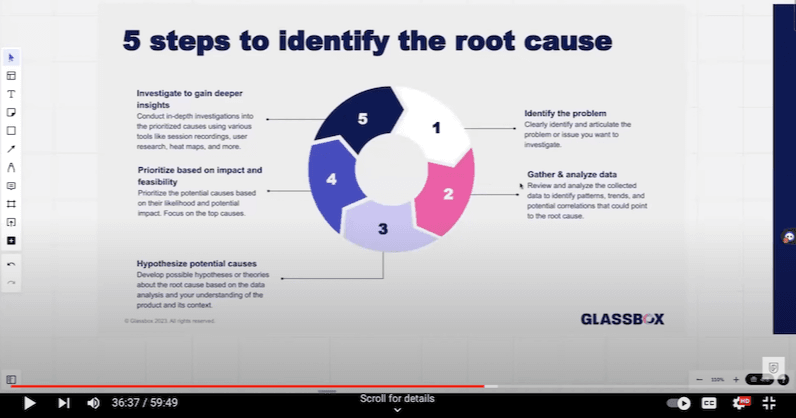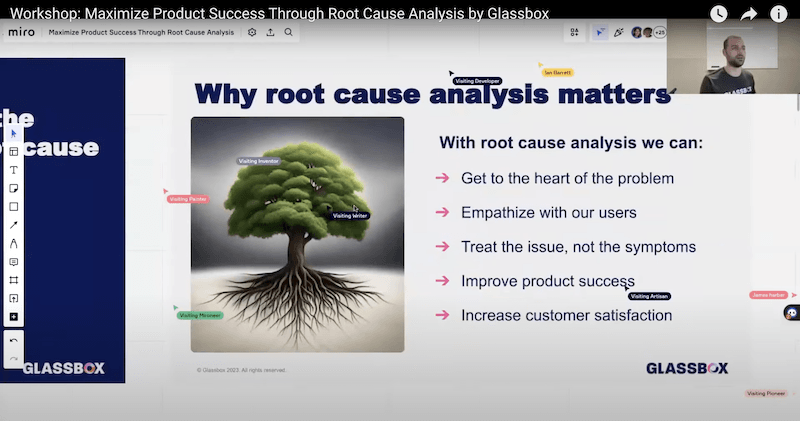Updated: July 1, 2024- 7 min read
Achieving product success is no easy feat. It’s the outcome of meticulously planned strategies and refined problem-solving skills. One pivotal practice, crucial to effective product management, is Root Cause Analysis (RCA). Understanding and implementing RCA can help you elevate your products' performance and, in turn, maximize product success. So let’s explore exactly what RCA is, how it works, and how to get buy-in from key stakeholders.
Editorial note: This post is based on a talk by Isaac Mardan, Senior Product Manager at Glassbox, on Maximizing Product Success Through Root Cause Analysis and contains additional insights and examples from the Product School team. You can watch the webinar in full below.
What is Root Cause Analysis?
Root Cause Analysis is a systematic process that helps identify the underlying causes of a problem. For instance, if you’re a Product Manager for a beauty subscription box company and you're having problems with high churn rates, you can use RCA to find out why.
Instead of merely treating the symptoms, RCA focuses on understanding the genesis of a problem. Treating problems at the root makes RCA a powerful tool in Product Management, and helps improve user experiences and maximize your chances of product success.
Sounds great, right? So how do you go about conducting your own Root Cause Analysis?
How to carry out Root Cause Analysis: a five-step process
To maximize its effect and derive the most valuable insights, you can streamline RCA with this five-step process:
1. Identify the Problem Clearly: This might seem like a no-brainer, but begin by identifying what you’re trying to investigate. It could be a variety of problems such as low conversion rates, users who are just not engaging with your product, or new features that are gathering dust.
2. Gather and Analyze Data: Now that you've got your problem in sight, it's time to gather your data. This involves collecting relevant information that can illuminate patterns, spotlight trends, and hint at potential correlations. In this stage, think of yourself as a detective, amassing clues but not getting too deeply committed to a single suspect (cause) just yet. Employ tools like Google Analytics, your product's internal data, user surveys, and customer feedback to gather data.
3. Hypothesize Potential Causes: Armed with data and your in-depth understanding of the product, you can now craft a list of potential culprits. What could be causing the problem? It's time to hypothesize. Each hypothesis should be based on your data analysis, but don't forget to add a dash of creativity and intuition honed from your experience with the product.
4. Prioritize Your Hypotheses: Now that you have your list of potential causes, it's time to prioritize. Not all causes are created equal. Some will have a larger impact, some will be more feasible to address, and some will align more closely with your product's mission and capabilities.
5. Investigate Top Causes: Having prioritized the potential causes, roll up your sleeves and delve deeper into the ones topping your list. Here's where you can utilize more specialized tools such as session recordings, user interviews, usability testing, and heat maps. These tools will offer richer, more detailed insights into the user behavior and interactions associated with the prioritized causes.

Root Cause Analysis: a continuous process
Bear in mind that RCA is not a one-time activity. It's a continuous process throughout a product's lifecycle. Like peeling an onion, sometimes, you need to go through several layers (or iterations) to reach the core of the issue. So don't get discouraged if you find yourself repeating these steps a few times. This repetition isn’t a sign of failure, but a testament to the complexity of the issues you're tackling. After all, no significant product issue was ever truly easy to solve, and no major success ever came without persistence and patience.
Root Cause Analysis in action: real-life examples
Now that you know how to conduct Root Cause Analysis, let’s see it in action in two real-world case studies.
Case study 1: One of the UK’s largest retail banks
Consider the example of a major UK bank that was experiencing low conversion rates for opening new accounts. They decided to employ RCA as their rescue strategy. Here’s how they did it using the five-step Root Cause Analysis:
Identifying the problem was easy – conversion rates were lower than expected. Next, they dug into the data, analyzing a multitude of metrics related to user behavior, bounce rates, and session times. This data treasure hunt led them to a few interesting hypotheses about potential causes, including a convoluted user interface and an onboarding form that was causing friction.
After prioritizing and investigating these hypotheses, they confirmed that these were the key issues that were stifling their conversion rates. With the insights they gained from RCA, they undertook strategic initiatives to address these issues, including revamping their UI, and simplifying the onboarding form. RCA, in this case, provided the compass pointing towards a solution.
Case study 2: Invisible product feature at Glassbox
In this second example, take the case of a new feature rolled out at a Glassbox. Despite high expectations, the adoption rate of the new feature was depressingly low. The team set out to investigate the problem using RCA, initially suspecting technical glitches to be the culprit.
However, the process of RCA quickly revealed that the issue was not in the machinery but in the visibility. The feature was, metaphorically, playing hide and seek with the users. Tucked away in the interface's corner, it wasn’t interacting with the users, nor were the users aware of its existence.
By increasing the visibility of the feature, adding a clear label, and launching an awareness campaign, the team managed to pull the feature out of obscurity and into the spotlight. User interaction and adoption rates rocketed, turning the initial stumble into a victory lap.
These examples not only showcase how RCA can get to the root of complex problems but also demonstrate its power in guiding the course of action toward better user engagement and product success.
The pros and cons of Root Cause Analysis in Product Management
As you’ve seen, RCA is an essential tool in a product manager’s toolkit. When executed effectively, it allows you to empathize with your users, understand their pain points, unearth the real reasons behind their struggles or dissatisfaction, and significantly boost product success. It empowers you to move beyond treating the symptoms to addressing the real issues, leading to an improved product and a happier customer base.

However, like every technique, it comes with its own set of challenges. Limited data access, the complexity of interrelated factors, and constraints in time and resources often make RCA seem daunting. Gathering the necessary data to understand complex issues and pinpointing the main root cause amidst multiple factors demands the right tools and resources. Additionally, the time and effort required for a thorough RCA can seem overwhelming amidst the rush of other priorities.
Despite these challenges, RCA remains a worthwhile investment and can serve as your trusty navigational compass in the complex map of product performance issues. It not only helps you identify and solve critical user issues but also leads to happier customers and better chances of product success.
Conveying the value of Root Cause Analysis
Just because you’re convinced of the power of Root Cause Analysis doesn’t mean others will be, so here’s a tip: If you find it challenging to get buy-in for RCA from other stakeholders, let the data do the talking. Show the time wasted and lack of impact from unsuccessful experiments and compare these with the results obtained when RCA was correctly conducted. The results of RCA truly speak for themselves – greater customer satisfaction and genuine product success.
Learn more with Product School
If you’ve enjoyed deepening your knowledge of product management and want to take your career to the next level, don’t miss out on our Product Leader Certification (PLC)®. Developed with top Silicon Valley Product Leaders, the (PLC)® will help you navigate your next major career transition by enhancing your analysis and leadership skills, and help you to own product strategy. Schedule a call today to find out more.
Updated: July 1, 2024





